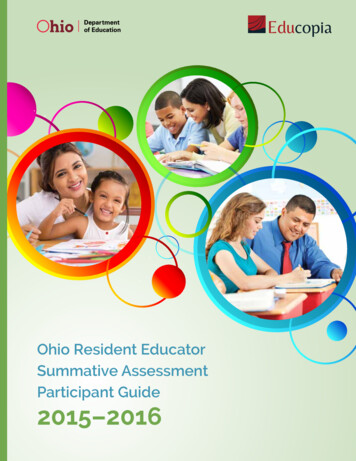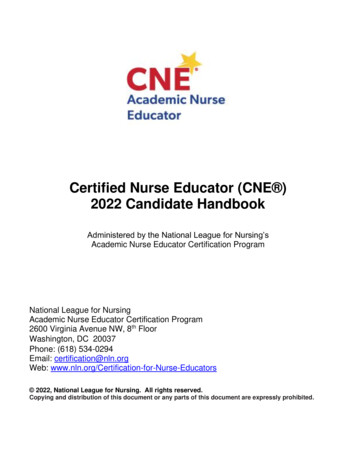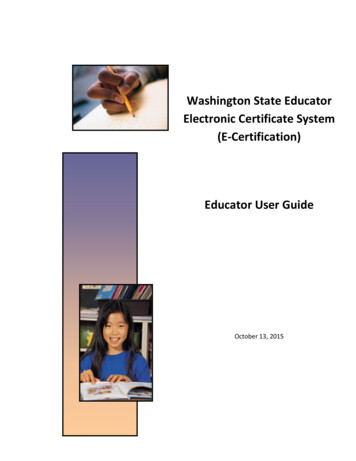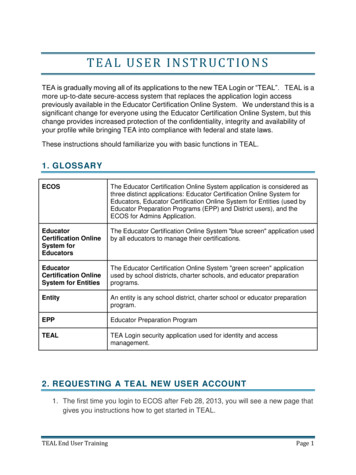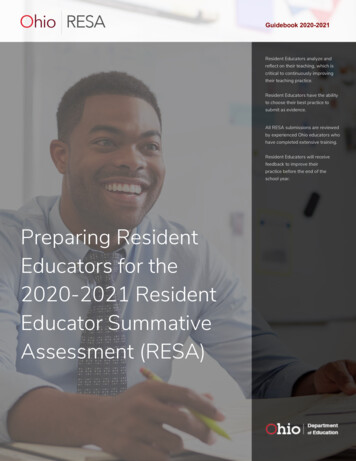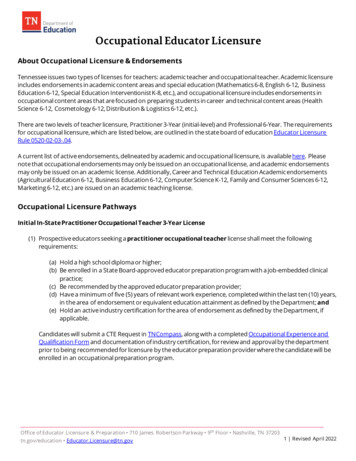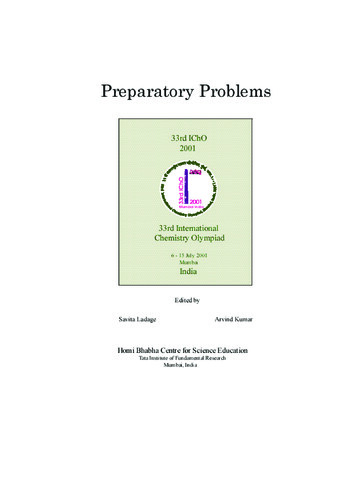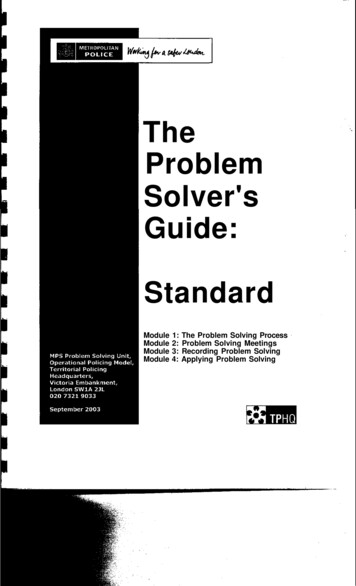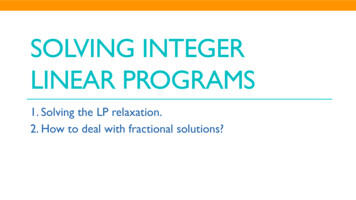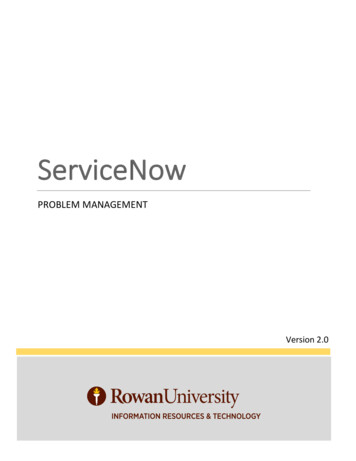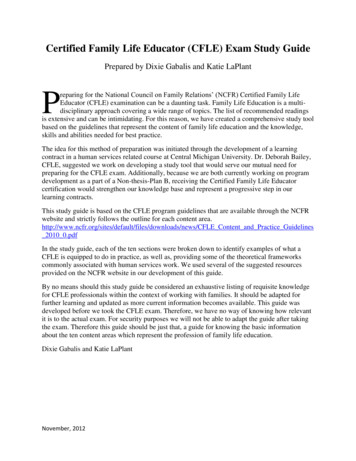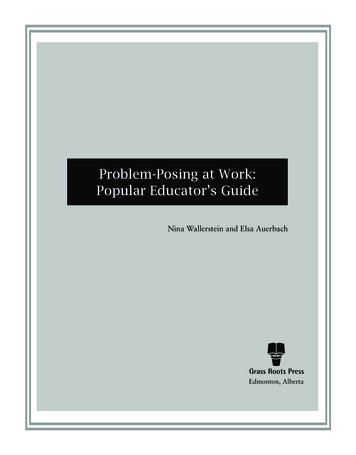
Transcription
1Problem-Posing at Work:Popular Educator’s GuideNina Wallerstein and Elsa AuerbachEdmonton, Alberta
Copyright 2004 Grass Roots PressThis book is protected by copyright. All rights reserved. No part of it may be reproduced or transmittedin any form or any means, electronic or mechanical, including photocopy, recording, or any informationstorage and retrieval system, without the prior written permission of the publisher.Problem-Posing at Work: Popular Educator’s Guide is published byGrass Roots PressA division of Literacy Services of Canada Ltd.PO Box 52192, Edmonton, Alberta, T6G 2T5, CanadaPHONE:FAXWEB SITECO-ORDINATOREDITORSCOVER DESIGNILLUSTRATORDESKTOPPRINTINGPHOTOGRAPHER:COVER s.comPat CampbellAnne Le Rougetel & Janet IsserlisLara Minja - Lime DesignNola JohnstonDebra HolsteinScancopy Print Inc.David BaconDavid BaconYouth Empowerment Strategies (YES!) Program,Public Health Institute, Berkeley.We acknowledge the support of the Alberta Foundation for the Artsfor our publishing program.Library and Archives Canada Cataloguing in PublicationWallerstein, NinaProblem-posing at work : Popular educator’s guide / Nina Wallerstein, Elsa Auerbach.Includes bibliographical references.ISBN 1-894593-33-21. Teaching. 2. Reflective teaching. I. Auerbach, ElsaLC196.W34 2004371.102C2004-905201-2Printed in Canadaii
AcknowledgmentsWriting this educator’s guide has been a wonderful opportunity to reflect on allwe have learned over the past thirty years as educators, especially on what wehave learned from people who have been our “teachers” in so many differentareas. We’ve had the good fortune of working with critical and popular educators inEnglish as a Second Language, adult education, health and safety education, laboreducation, public health and health promotion, adolescent empowerment education,graduate education, and community-based participatory education and research. We’vealso had the good fortune of teaching and working with many diverse groups of studentsand communities (immigrants, multiple generation Latino/Hispanic and Asian, AmericanIndian, African-American, poor and working class people), and others who have offeredus incalculable learnings.We would like to pay tribute to the many organizations whose work has createdpossibilities for change and given hope to immigrant workers. Among these are SEIULocal 1877 (Oakland, CA); the Center for Labor Research and Education (CLRE),(University of California Berkeley); the Labor Occupational Health Program (Universityof California Berkeley); the Center for Labor Research and Education (University ofCalifornia Los Angeles); the Worker Education Program of SEIU Local 285 (Boston,MA); La Mujer Obrera (El Paso, TX); Asian Immigrant Women’s Advocates (Oakland,CA); Centro Presente (Cambridge, MA); the Canadian Labour Congress (Ottawa); SouthEnd Press (Boston, MA); the Highlander Center for Research and Education; and Jobswith Justice. We have also learned from the many popular educators (many of whom arelisted in the Appendix), people whom we have worked with, read, and valued from closeand from a distance. Finally, we appreciate the support and faith that Pat Campbell ofGrass Roots Press has shown in our work. Of course, any errors and inaccuracies are ourresponsibility alone.NINA: Individuals who helped me think through this Popular Educator’s Guideinclude Pia Moriarty, my early partner in Freirian workshops; Carlos Flores, who hascommented on the material from the perspective of a community organizer and counselor;Jenny Utech, who described concisely how a problem-posing curriculum unfolds; BonnieDuran, who has supported me to reflect clearly on oppression, white privilege, and thevalue of intention-based practice; Meredith Minkler, who has generously offered criticalappraisal of my work; Nance Wilson and Stefan Dasho, who gave me many opportunitiesto facilitate dialogical training with the Youth Empowerment Strategies Program; andDavid Dunaway, my life partner, who has challenged and supported me to practice what Iadvocate. I owe a tribute to many other friends, co-workers, and students whose countlessconversations over the years have strengthened my thinking on facilitation, education, andsocial change.I dedicate this book to my parents who were my earliest teachers. To them, I amgrateful for their commitment to honesty, to self-reflection, and to integrity of their beliefs.ELSA: Individuals whose work has contributed to English for Action include WarrenMar of the Center for Labor Research and Education (University of California Berkeley),for interviews with immigrant workers; Alison Webber of SEIU 1877 (Oakland), for hercareful reading of an early draft of the manuscript; Miriam Ching Louie of the Womeniii
of Color Resource Center, for the inspirational book, Sweatshop Warriors, documentingthe courage and struggles of immigrant women in the workforce; David Bacon, for hispowerful photos of immigrant workers; Jenny Utech, for ideas that influenced several ofthe lessons; Tamara Levine, for resources related to worker education in Canada; JenaCampo, for connections to La Mujer Obrera; Maria Elena Letona, for the extensiveinterview on globalization and immigration; Beth Thompson, for her work with Elena;and Janet Isserlis, for her careful editing.I, too, would like to dedicate my contributions to these books to my parents, who, asrefugees to the U.S., were the first to teach me about the struggles of newcomers as well asthe importance of fighting against tyranny and for social justice.iv
Table of ContentsPreface . . . . . . . . . . . . . . . . . . . . . . . . . . . . . . . . . . . . . . . . . . . . . . . . . . . . . . . . . . . . . . .1Who is this book for? . . . . . . . . . . . . . . . . . . . . . . . . . . . . . . . . . . . . . . . . . . . . . .1What is our philosophy? . . . . . . . . . . . . . . . . . . . . . . . . . . . . . . . . . . . . . . . . . . . .1Who are we? . . . . . . . . . . . . . . . . . . . . . . . . . . . . . . . . . . . . . . . . . . . . . . . . . . . . .3Why are we revising? . . . . . . . . . . . . . . . . . . . . . . . . . . . . . . . . . . . . . . . . . . . . . . .3How is this popular education book structured? . . . . . . . . . . . . . . . . . . . . . . . . . .5What are our next steps? . . . . . . . . . . . . . . . . . . . . . . . . . . . . . . . . . . . . . . . . . . . .5References . . . . . . . . . . . . . . . . . . . . . . . . . . . . . . . . . . . . . . . . . . . . . . . . . . . . . . .6Chapter 1: Teaching Approach . . . . . . . . . . . . . . . . . . . . . . . . . . . . . . . . . . . . . . . . . . . . .7What is problem-posing? . . . . . . . . . . . . . . . . . . . . . . . . . . . . . . . . . . . . . . . . . . .7What is empowerment and power? . . . . . . . . . . . . . . . . . . . . . . . . . . . . . . . . . . .9How do we engage in the cyclical process of reflection and action? . . . . . . . . . . .13How do we develop a problem-posing curriculum and process? . . . . . . . . . . . . .20What are our own problem-posing themes as educators? . . . . . . . . . . . . . . . . . .21References . . . . . . . . . . . . . . . . . . . . . . . . . . . . . . . . . . . . . . . . . . . . . . . . . . . . . .28Chapter 2: Teaching Strategies and Tools . . . . . . . . . . . . . . . . . . . . . . . . . . . . . . . . . . . .31Introduction . . . . . . . . . . . . . . . . . . . . . . . . . . . . . . . . . . . . . . . . . . . . . . . . . . . .31Listening in class or in structured settings . . . . . . . . . . . . . . . . . . . . . . . . . . . . . .32Listening outside class . . . . . . . . . . . . . . . . . . . . . . . . . . . . . . . . . . . . . . . . . . . . .33Dialogue with codes . . . . . . . . . . . . . . . . . . . . . . . . . . . . . . . . . . . . . . . . . . . . . .35Questions for dialogue . . . . . . . . . . . . . . . . . . . . . . . . . . . . . . . . . . . . . . . . . . . .37Role of the educator in group dialogue . . . . . . . . . . . . . . . . . . . . . . . . . . . . . . . .41Example of problem-posing dialogue . . . . . . . . . . . . . . . . . . . . . . . . . . . . . . . . .43Action . . . . . . . . . . . . . . . . . . . . . . . . . . . . . . . . . . . . . . . . . . . . . . . . . . . . . . . . .46Visioning . . . . . . . . . . . . . . . . . . . . . . . . . . . . . . . . . . . . . . . . . . . . . . . . . . . . . .47Written dialogues, role plays, or case studies . . . . . . . . . . . . . . . . . . . . . . . . . . . .48Life stories . . . . . . . . . . . . . . . . . . . . . . . . . . . . . . . . . . . . . . . . . . . . . . . . . . . . . .48Realia and outside texts . . . . . . . . . . . . . . . . . . . . . . . . . . . . . . . . . . . . . . . . . . . .49Pictures (photographs, drawings, collages, slides, puppets) . . . . . . . . . . . . . . . . .50Photovoice . . . . . . . . . . . . . . . . . . . . . . . . . . . . . . . . . . . . . . . . . . . . . . . . . . . . . .51Risk maps or charts . . . . . . . . . . . . . . . . . . . . . . . . . . . . . . . . . . . . . . . . . . . . . . .52More social analysis and action planning methods . . . . . . . . . . . . . . . . . . . . . . .52Participatory research . . . . . . . . . . . . . . . . . . . . . . . . . . . . . . . . . . . . . . . . . . . . .53Immigrant participatory arts: (contributed by Pia Moriarty, 2004) . . . . . . . . . . .54Hands-on activities and physical activity . . . . . . . . . . . . . . . . . . . . . . . . . . . . . .54Additional language instruction issues . . . . . . . . . . . . . . . . . . . . . . . . . . . . . . . .55Evaluation . . . . . . . . . . . . . . . . . . . . . . . . . . . . . . . . . . . . . . . . . . . . . . . . . . . . .57Language and Culture in Conflict triggers . . . . . . . . . . . . . . . . . . . . . . . . . . . . . .58References . . . . . . . . . . . . . . . . . . . . . . . . . . . . . . . . . . . . . . . . . . . . . . . . . . . . .61v
vi
Chapter 3: An Example of a Problem-Posing Workplace ESL Cycle . . . . . . . . . . . . . . . .65Introduction . . . . . . . . . . . . . . . . . . . . . . . . . . . . . . . . . . . . . . . . . . . . . . . . . . . .65The students . . . . . . . . . . . . . . . . . . . . . . . . . . . . . . . . . . . . . . . . . . . . . . . . . . . .65Hospital and union goals . . . . . . . . . . . . . . . . . . . . . . . . . . . . . . . . . . . . . . . . . . .66Teacher goals . . . . . . . . . . . . . . . . . . . . . . . . . . . . . . . . . . . . . . . . . . . . . . . . . . . .66Reading, writing, and talking about work . . . . . . . . . . . . . . . . . . . . . . . . . . . . . .66Class rituals, routines, and language work activities . . . . . . . . . . . . . . . . . . . . . .67Speak up for your rights . . . . . . . . . . . . . . . . . . . . . . . . . . . . . . . . . . . . . . . . . . .68Workers’ rights in Massachusetts . . . . . . . . . . . . . . . . . . . . . . . . . . . . . . . . . . . .69Looking at the union contract . . . . . . . . . . . . . . . . . . . . . . . . . . . . . . . . . . . . . . .69Union steward roles . . . . . . . . . . . . . . . . . . . . . . . . . . . . . . . . . . . . . . . . . . . . . . .70Visit from a union representative . . . . . . . . . . . . . . . . . . . . . . . . . . . . . . . . . . . . .70Successes . . . . . . . . . . . . . . . . . . . . . . . . . . . . . . . . . . . . . . . . . . . . . . . . . . . . . . .70Challenges . . . . . . . . . . . . . . . . . . . . . . . . . . . . . . . . . . . . . . . . . . . . . . . . . . . . . .71Taking action . . . . . . . . . . . . . . . . . . . . . . . . . . . . . . . . . . . . . . . . . . . . . . . . . . .72References . . . . . . . . . . . . . . . . . . . . . . . . . . . . . . . . . . . . . . . . . . . . . . . . . . . . . .72Chapter 4: Connecting Local and Global Action:The Role of Pedagogy in Social Change . . . . . . . . . . . . . . . . . . . . . . . . . . . . . . . . . . . . .73Forces of globalization . . . . . . . . . . . . . . . . . . . . . . . . . . . . . . . . . . . . . . . . . . . .74Implications for education . . . . . . . . . . . . . . . . . . . . . . . . . . . . . . . . . . . . . . . . .78Diversifying contexts for education . . . . . . . . . . . . . . . . . . . . . . . . . . . . . . . . . . .79Social change organizations or movements . . . . . . . . . . . . . . . . . . . . . . . . . . . . .80Conclusion . . . . . . . . . . . . . . . . . . . . . . . . . . . . . . . . . . . . . . . . . . . . . . . . . . . . .85References . . . . . . . . . . . . . . . . . . . . . . . . . . . . . . . . . . . . . . . . . . . . . . . . . . . . . .86Chapter 5: Guide to Activities in Problem-Posing at Work:English for Action (revised edition) . . . . . . . . . . . . . . . . . . . . . . . . . . . . . . . . . . . . . . . .89The book as a whole . . . . . . . . . . . . . . . . . . . . . . . . . . . . . . . . . . . . . . . . . . . . . .89Within each lesson of English for Action (revised edition) . . . . . . . . . . . . . . . . .94A final word on “hot topics” . . . . . . . . . . . . . . . . . . . . . . . . . . . . . . . . . . . . . . . .98AppendixSelected resources . . . . . . . . . . . . . . . . . . . . . . . . . . . . . . . . . . . . . . . . . . . . . . . .99Resources on labor education and participatory labor education . . . . . . . . . . . .99Resources on workplace issues . . . . . . . . . . . . . . . . . . . . . . . . . . . . . . . . . . . . .100Resources on globalization . . . . . . . . . . . . . . . . . . . . . . . . . . . . . . . . . . . . . . . .101Resources on popular and participatory education . . . . . . . . . . . . . . . . . . . . . .102Newsletters and journals . . . . . . . . . . . . . . . . . . . . . . . . . . . . . . . . . . . . . . . . . .105Organizational addresses . . . . . . . . . . . . . . . . . . . . . . . . . . . . . . . . . . . . . . . . . .106vii
viii
PrefaceWho is this book for?This is a book for educators who are interested in engaging in critical reflectionand social action. It is for educators from diverse fields: community and adulteducators, English as a Second Language and literacy teachers, public healtheducators, labor organizers, health and safety educators, community psychologists andfacilitators, high school teachers, and faculty in teacher education and other professionaleducation programs.This is also a book for organizers and activists who want to engage in reflectivepractice and who believe in personal and community transformation as part of theorganizing process. It is for all of us who envision a different world—one that respectslearners, creates democratic opportunities for learning, and views people as creators oftheir lives, both inside and outside the classroom. It is a book for those of us who believein the promise of personal and social change, not just for the communities with whom wework, but also for ourselves and for our own participation in societal change.This book has two purposes. It is both a companion teacher’s guide to the revisededition of the student book, Problem-Posing at Work: English for Action; and it is aseparate educator’s guide that explores problem-posing, critical reflection, and action.One of the challenges we faced in revising the earlier ESL for Action was the question ofaudience and readership. We wanted to continue to speak to ESL teachers, yet at the sametime speak to the reality of educators and organizers across many content areas.The educator’s guide, therefore, presents our philosophy, and our strategies that havebeen helpful over the years in practicing problem-posing education in many differentworkshop, classroom, and community settings. In addition to strategies, we havetaken the opportunity to pose dilemmas we have faced in doing this work in order topromote critical discussion. These dilemmas have included the challenges within our owninstitutions; within the changing international, national, and local contexts; and withinour own practice as educators.The revised student book, Problem-Posing at Work: English for Action extends theprevious problem-posing approach to learning English in worksite settings by providinggreater depth, range of activities, stories, and examples that promote English languagedialogue and actions. It covers the themes of the daily work lives of immigrants, both pastand present; their interactions with each other, with American co-workers, supervisors,and unions; their concerns with working conditions, health and safety, and stress; andtheir legal and organizing rights to improve conditions; and it extends these themes acrossthe U.S.-Canadian border.What is our philosophy?The two books together are based on an educational process of dialogue called"problem-posing" that starts from students' lives and asks them to "believe in themselves. . . that they have knowledge." Problem-posing assumes that education is not value-free
Problem-posing at work: Popular educator’s guidebut is embedded in a social context. Immigrants or community members bring to theclassroom a richness of experience: their knowledge, their troubles, their strengths, andtheir skills. By inviting students and teachers to participate as co-learners, problem-posingenables students to shape their own learning, to think critically, and to make decisionsoutside the classroom that may set new directions for their lives.In addition to the term “problem-posing education,” related and overlapping conceptshave circulated in this field. These include: “popular education,” from the historicallegacy of education and organizing in Latin America; “Freirian education,” from oneof its major theorists and practitioners, Brazilian educator Paulo Freire; “participatoryeducation,” with its focus on learner participation in curriculum development andcommunity activism; “empowerment education,” with its recognition of the role of powerdynamics; and “educating for social change,” with its focus on the goal of problemposing.While the concepts have historical or contextual differences, they share severalpremises, each of which builds on the other. The first premise is that we as educatorsare constantly learning, that we benefit from critical reflection on our own values andknowledge bases, our own teaching styles, the material we present, and the methods thatwe choose. We are truly co-learners with our students.The second premise is that we as educators have an important role to play with ourstudents: to prepare and direct learning opportunities that encourage students to believein their capacities as critical thinkers and actors in their own lives. This premise reclaimsour responsibilities as educators to be more than co-learners: to be leaders who bringour resources to contribute to the learning and to foster a safe environment for criticaldialogue.The third premise is that education is political, and that “power” and “empowerment”are central to the educational process. Education either acts to disempower students andourselves to accept life situations, or it engages us to challenge oppressive or difficultconditions in our lives. Within this premise, we look to understand how power operates ata societal or institutional level, within our personal interactions, and within ourselves.The fourth and final premise is that this type of education opens the door for multipleparadoxes, questions, or dilemmas that are not always solvable. These “problem-posing”opportunities mirror what may happen in the classroom with our students, and theyrequire us as teachers to make choices in the context of each specific teaching opportunity.We will find ourselves making a variety of choices in different situations, especially as wegrow in our own teaching careers.We may not always have answers or there may be several possible answers, butadopting a problem-posing stance gives us a unique opportunity to practice a process ofcritical reflection and action with other educators and organizers that is similar to theprocess we foster with our students and community members.The educator’s guide explores these premises and paradoxes; provides a guide tothe problem-posing approach, methods, and tools that can help in the classroom andcommunity; and, finally, articulates a set of reflections for becoming more mindful andskillful in our teaching. By applying this approach to language education, the revisedstudent book, Problem-Posing at Work: English for Action, provides one model ofpractice with the hope that we will contribute to the capacity of educators to engage inproblem-posing education.2
PrefaceWho are we?We come to the writing of this book from our own personal, educational and politicalhistories as well as from our desire to sharpen our own reflections from the past twentyyears.More than twenty years ago, Nina Wallerstein wrote Language and Culture inConflict: Problem-Posing in the ESL Classroom, one of the first Freirian texts for teachersof English as a Second Language. Starting when she was twenty years old, she taughtEnglish as a Second Language for ten years; in the early years, co-developed teachertraining workshops (with Pia Moriarty); and simultaneously participated in the anti-warand women’s movements. She later moved into the health arena, receiving her master’sand doctorate in public health, and adapted Freirian approaches to public health andhealth education with the goal of integrating educational approaches and organizing.She has developed empowerment and community organizing trainings within the U.S.,Canada, and Latin America, and has worked with immigrants, union members on healthand safety efforts, youth, women, and tribal populations, and healthy community effortsworld wide. Her latest book is Community-Based Participatory Research for Health(co-edited with Meredith Minkler). As a white woman, often working in communities ofcolor, she has reflected on issues of power and privilege, and on her responsibility to usethe resources available to her to challenge conditions of racism and marginalization.Elsa Auerbach started as a young activist, trying to join the NAACP when she wastwelve, marching against apartheid when she was eighteen, joining an anti-imperialistresearch group when she was twenty-two, and working in an auto factory for five yearsas a would-be labor organizer after getting her doctorate in linguistics. Freire’s workguided her in integrating her political and academic background. She has providedteacher education classes and workshops for twenty years and, as a professor of Englishat the University of Massachusetts, has written such books, as Making Meaning, MakingChange: Participatory Curriculum Development for Adult ESL Literacy (1992), and Fromthe Community to the Community: A Guidebook for Participatory Literacy Training(with Barahona, Midy, Vaquerano, Zambrano & Arnaud (1996)). Like Nina, she hasreflected on her own positionings in terms of class, race, and educational background andhas attempted to use the resources available to her in service of social change.In the mid-1980s, Elsa and Nina joined together to co-write an ESL book forimmigrant workers and a teacher’s guide, ESL for Action: Problem-Posing at Work.Now, fifteen years later, with both ESL for Action and Language and Culture in Conflictout of print, we decided to revise the student book as English for Action, and to producea new Popular Educator’s guide that provides guidelines into Freirian pedagogy andeducational tools, but also reflects on the paradoxes and dilemmas of problem-posingeducation.Why are we revising?The timing of this revision is paradoxical. Within the last two decades, globalizationand the continued movement of capital and populations has produced a world withgreater inequities than ever before—inequities between richer and poorer countries,and between richer and poorer peoples within countries. The disparities in the U.S.3
Problem-posing at work: Popular educator’s guideand Canada have grown, with immigrants having less access to educational and socialservices, and worse health and economic status. In addition, factors of race, gender,neighborhood conditions, and educational status have intensified the gaps between richand poor. The flip side to the growing inequities has been that globalization has alsoincreased technological connections between historically disenfranchised peoples andmade world-wide mobilization a possibility (as we saw with the international anti-Iraqorganizing and the disruption of the World Trade Organization free trade agreements,mobilized through the web).It is a different world now than when we first started working together. We have newunderstandings based on changes in our practice in these intervening years (Nina in publichealth and labor education; Elsa in ESL and teacher education). Our dialogue within acommunity of Freirian educators and our recognition of changed global conditions haveshaped these understandings.Within our practice, when we first started doing this work, we were passionate andbelieved that all educators who cared deeply about student respect, critical thinking, andpolitical change would welcome this approach. Over the years, however, both of us haveexperienced questions and concerns, hesitations, and even resistance to the problemposing approach. We have heard, “Problem-posing is too difficult. It’s too hard to getdiscussion going with students.” Or, “Issues take too much work. It’s too hard to trackdown all the answers.” Some have expressed their fears. “This is too dangerous. I’mscared I won’t be able to handle the issues that arise. What if I can’t solve the problems?”Some fear being too political. “How do I know that I’m not imposing my own views ofchange on students?” “My students don’t want to think about their problems. They thinktheir life here is okay.” Or, “It’s arrogant to think I’m more enlightened or think morecritically than my students.” And, for beginning ESL students, “My students don’t knowenough English to do this stuff.”While we remain passionate about our educational approach, we have learned thatthese challenges represent an important set of paradoxes for us as political educators totake seriously: to identify, think about, and “problematize” so that we can learn aboutand deepen our own stances and the stances of others. In this educator’s book we hope toprovide a context for reflecting on some of these paradoxes and for encouraging continualreflection on teaching.Within our national contexts this is also a paradoxical time for educational policy.Standardized tests are on the increase, accelerated with the “No Child Left Behind Act”in the United States. Teaching to the test has been part of citizenship classes for the lastseveral decades. Yet, despite the potential stifling of educational creativity, participatoryapproaches to education have become accepted practice within the profession. Freirianeducational texts have become standard fare for many teacher education and healtheducation programs. Community programs, foundations, non-profits, universities, aswell as child and adult educational systems are looking for strategies that hold promisefor dealing with the complex social reality of our world. Other perspectives from poststructuralism, post-colonialism, and feminism have become part of the dialogue ineducational circles.We owe a great tribute to the surge of popular education/problem-posing booksduring the last two decades and to the countless others world wide who have engaged4
Prefacein this kind of work, but who may not have had the opportunity or time to write abouttheir experiences. While we don’t pretend to know the richness of all the Freirian andproblem-posing work internationally, we have attempted to provide a list in the Appendixof selected adult education and training books and groups who have been most influentialin our own work, particularly with regard to English as a Second Language and literacyeducation. We also owe a tribute to our colleagues who have written thoughtful critiquesof Freirian education and who have enabled us to articulate more clearly the paradoxeswe face.How is this popular education book structured?Chapter 1. Teaching Approach introduces the general framework for problem-posingeducation; it includes several models such as listening/dialogue/ action, the praxis cycleof reflection and action, and the participatory spiral; and it explores the paradoxes andmyths of the overall framework of Freirian education.Chapter 2. Teaching Strategies provides specific tools for implementing problemposing education, and updates the tools from ESL for Action to include new strategiesfrom labor, public health, and adult education as well as from community-basedparticipatory research. It includes guidelines for the development of codes, providesexamples of codes from Language and Culture in Conflict, presents an elaboratedproblem-posing dialogue, and discusses evaluation of codes.Chapter 3 is an account by labor educator Jenny Utech of a one-year participatorycycle in an ESOL class for union workers, jointly sponsored by union and management ina large urban hospital.Chapter 4. Connecting Local and Global Action gives an overview of the context ofglobalization and its implications for literacy, ESL, adult basic education, public health,and the broader arena of educational programs that aim to support social change.Chapter 5 provides an inside look at how the accompanying student book, Englishfor Action, embraces a problem-posing approach through its flow of activities, its specificexercises, and its emphasis on the praxis of action and reflection.What are our next steps?Change—personal, educational, or social—is an ongoing and difficult process. Inproblem-posing, change can start with education in the classroom, enabling students togain self-confidence within the classroom community as co-learners and decision-makers.Change can start in community organizing settings such as advocacy organizations,support groups, and neighborhoods.But the process of change demands time and continuing commitment. We thereforeinsist our educat
The revised student book, Problem-Posing at Work: English for Action extends the previous problem-posing approach to learning English in worksite settings by providing greater depth, range of activities, stories, and examples that promote English language dialogue and actions. It covers the themes of the daily work lives of immigrants, both past
